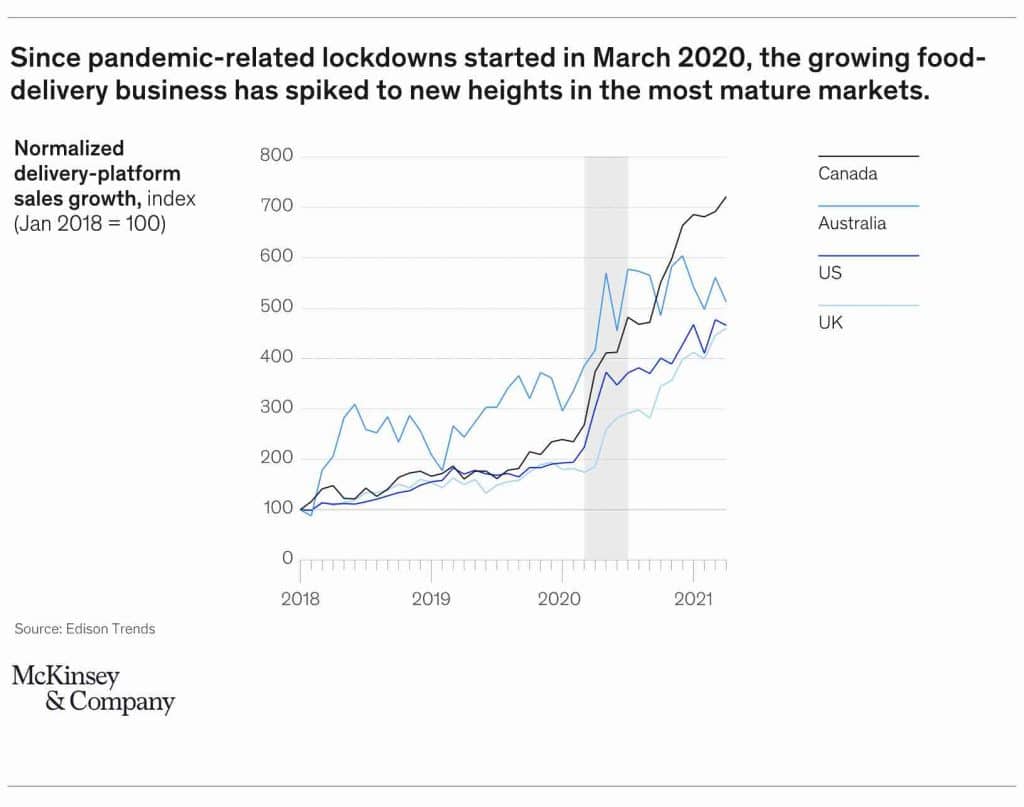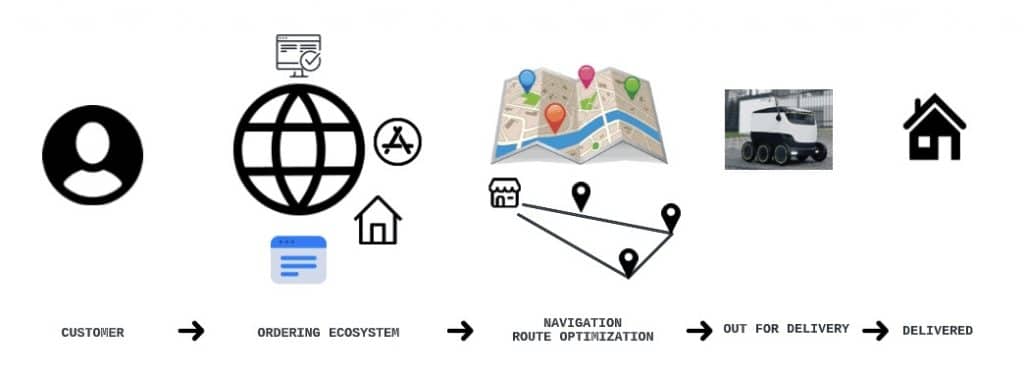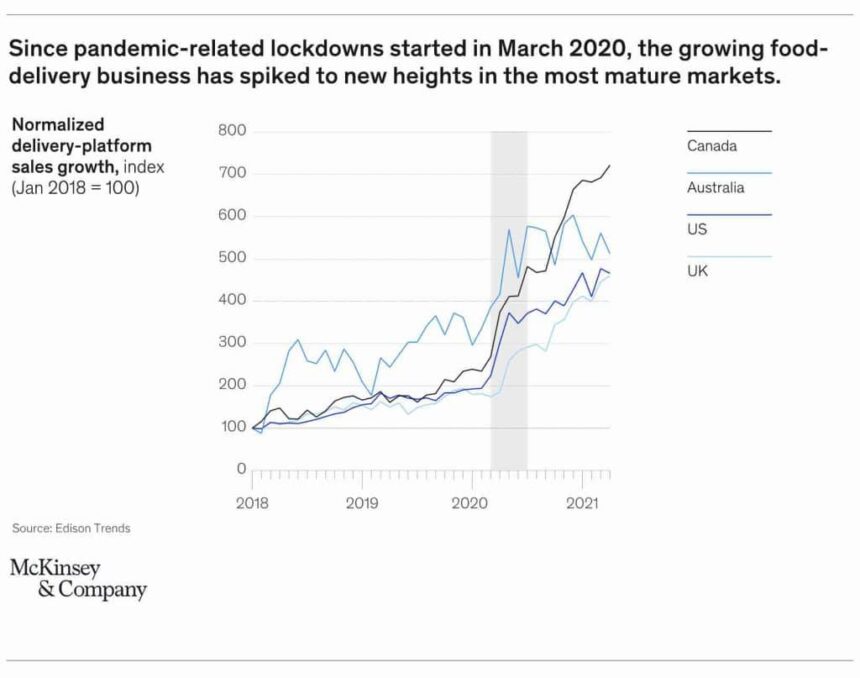Introduction
The pandemic caused food delivery in restaurants to skyrocket. Companies like Uber Eats, DoorDash, and Grubhub have become essential tools for hungry people everywhere. But now, a new competitor has emerged: autonomous delivery robots. Using a combination of cutting-edge technologies, delivery robots can make food deliveries with unprecedented accuracy.
What impact will these have on the delivery process? Will they completely replace human delivery drivers? This blog post will examine these questions and more.

Table of contents
Also Read: Robot Powered Pizza Chain Of The Future.
What is a Food Delivery Robot?
First things first, we must understand what a food delivery robot is. In essence, a food delivery robot is an autonomous vehicle that can navigate to the customer’s location and deliver their order without human intervention. Instead of being created by the restaurant, these autonomous robots are usually deployed by a tech company with a fleet of robots working around the clock.
Autonomous deliveries have already become commonplace in some cities, with robots driving themselves down sidewalks, delivering food to customers without a hitch. Intelligent delivery is the term used to describe this process.
How does a Food Delivery Robot Work?
So, what goes into building delivery robot projects? The first thing we need to understand is artificial intelligence (AI). AI is the process of creating software that has the ability to think, make decisions and act on them. This is a crucial component of delivery robots, as they require the capability to navigate their way around obstacles and find their destination independently.
Autonomous food delivery robots use a combination of LiDAR sensors, cameras, and GPS to get around. LiDAR (Light Detection and Ranging) measures distance by bouncing light off objects in the environment. Cameras detect obstacles, recognize different types of surfaces, and help the robot plot its course. Finally, GPS helps the robot pinpoint its exact location to reach the customer’s house.
These machines run on electric batteries, with a motor that powers the wheels and moves the robot forward. The robot also needs a compartment for holding the food. Restaurants simply place the food into the robot’s container, usually insulated to keep the meal warm (or cold) until it reaches its destination.

Food Delivery Robots
The main application of technology is to create functional and efficient solutions to everyday problems like food robot deliveries. Regarding automation with robots, they are no longer “just a prototype” but actual delivery vehicles already hard at work. We have seen examples of these robots in universities, college campuses in San Francisco, Utah, and Santa Monica as demand for food delivery or market for food delivery was huge.
Let’s look at some of the popular food delivery companies already using robots for their deliveries.
Dax Delivery Robots
Daxbots, as they’re sometimes called, are among the first autonomous delivery robots to enter the market. Self-described as a movie-type robot, Daxbots are eerily similar to the robots in WALL-E. They even have trademark tank treads on the bottom for navigating various types of terrain.
Daxbots are powered by AI and machine learning algorithms, allowing them to make real-time decisions and adjust their route as needed. Dax works with multiple chips that each serve a specific function. With a delivery range of 2.5-10 miles, they are perfect for short-distance deliveries.
An intelligent electric battery pack can quickly be replaced or recharged, allowing the robot to work for longer periods of time.
Starship Delivery Robots
Starship Technologies recently took over The University of Tennessee when they deployed their delivery robots on campus. Social media went wild when Starship robots were spotted making deliveries to students. Around 20 other schools, including George Mason University and the University of Pittsburgh, have also benefited from Starship’s delivery robots.
These robots are about the size of a cooler and come equipped with six sturdy wheels. They move at a maximum speed of 4mph, which is slow enough to keep them safe on sidewalks and other pedestrian areas. The Starship robots use sensors and AI mapping software to deliver packages everywhere on campus. It enables the robot to position itself in space to the nearest inch.
In the case where autonomous delivery robots encounter an insurmountable obstacle, a remote operator can be alerted to take over the robot and guide it to safety. The Starship Technology website recently announced over 4 million autonomous deliveries completed by its robots, a testament to their reliability.
Nuro Pizza Delivery Robots
Advances in technology continue to amaze us. Nuro, an autonomous vehicle startup based in Mountain View, California, has developed its own pizza delivery robot. Unlike the two other small delivery robots mentioned above, the Nuro R2 robot looks and behaves nothing like a traditional car. These driverless cars recently partnered with Domino’s pizza to serve select customers.
It was the first driverless car to receive approval from the U.S. Department of Transportation, an incredible feat in itself. R2 is about half the size of a car and has a large compartment for carrying orders. The electric self-driving delivery vehicle moves at a maximum speed of 45mph, making it one of the fastest delivery robots in operation today. The company also uses it to deliver other items, such as medication and groceries.
As for how it works, the process is fairly simple. Customers may opt for an R2 delivery option during the checkout process if they are within the designated areas. Once the pizza is complete, the robot will be dispatched to deliver it. Customers receive a text message with an access code when the robot is on its way. It will pull up to the curb, where the customer can meet it and enter the pin to open its compartment and retrieve their order.
Benefits of Food Delivery Robot
Understandably, many companies are itching to test out robots for food delivery. The advantages of using robots to deliver food are many. Here are some of the most prominent benefits:
Routes Optimization
Food delivery service relies on speed and efficiency, and robots are great at both. Customers want to get their food while it is hot, and with robots, you can ensure it reaches them promptly. The robots use advanced algorithms to optimize the shortest route possible, reducing delivery time and ensuring customers get their food as quickly as possible. Plus, sidewalk navigation technology enables the robots to move around without gridlocking traffic.
Sustainability
The most crucial factor is that delivery robots are environmentally friendly. They run on electric power, meaning they don’t emit harmful gasses or hazardous pollutants into the air. This allows companies to reduce their carbon footprint while still meeting customer demand in a timely manner.
Companies like Uber Eats use cars that guzzle up fuel, contributing to air pollution. Oftentimes, drivers leave their cars running while waiting for the food to be prepared, further aggravating the problem. They also cover vast distances with only a few pounds of food aboard. Food delivery robots help reduce this kind of waste and make the process more sustainable overall.
Cost-Savings
Another great advantage of delivery robots is that they are incredibly cost-effective. Companies don’t need to hire drivers or pay for insurance and other costs associated with maintaining a fleet of vehicles. These savings translate into lower delivery fees customers pay. And with a reduced delivery charge, customers are more likely to order more often.
Attract Positive Attention
Due to their novelty and cute demeanor, robots can attract plenty of attention. They make a unique impression on customers, which could be used to great advantage by the company. The robots themselves may act as walking advertisements for brands, delivering food with style and flair that catches people’s attention.
Safety
Robotics technology makes it possible to deliver food safely and securely. Delivery robots are equipped with a host of sensors and cameras that enable them to detect obstacles and adjust their paths accordingly. This is in contrast to delivery drivers, who often operate under less-than-ideal conditions.
Human drivers are known to bend the rules, such as driving faster than they should or texting while driving. Delivery robots eliminate these worries and make food delivery safer for everyone involved.
Also Read: Food Robotics – Robots Are Evolving To Take Over The Food Industry
Challenges of Food Delivery Robot
Despite the many advantages of delivery robots, some challenges still need to be addressed.
Learning Curve for Restaurants
Many restaurateurs weren’t that ecstatic about being forced into offering gig-style delivery. They had to learn how to adapt their business processes to the new model and had to invest in specialized software and hardware. Restaurants will have to adopt a similar approach when deploying robots for delivery.
It may take some time to become comfortable with this new business method. Employee training and other disruptions to workflow should be taken into consideration.
Doesn’t Necessarily Benefit The Workers
Besides the obvious delivery people who may be displaced, robots might not have the desired effect on the food industry. You would think that lower operating costs and better efficiency would free up more money to pay the staff, but that’s not always the case. If we look at past instances of technology supporting front-line workers, we can see that it’s often just a way for companies to cut costs further and increase profits for the elite.
Reliability
Despite the clear advancement in automation technology, delivery robots still aren’t 100% reliable. Weather conditions, power outages, and other problems can easily throw a wrench in the system. Theft is also something to consider. As of now, it is mostly curbed by a high-pitched alarm that the robots emit when someone gets close. However, that is not foolproof, and criminals are known to find resourceful ways to work around deterrents.
Finally, the operating range is another shortcoming of the driverless delivery industry. Most robots are considered “last mile” delivery vehicles, meaning they can only travel a limited distance from the restaurant.
Also Read: Which Companies Use Drone Delivery?
Conclusion
The demand for food deliveries has been on a meteoric rise in the past couple of years and is only expected to increase, to the detriment of our planet. Delivery robots are poised to revolutionize the industry with their eco-friendly approach and increased safety. It is clear that driverless technology is here to stay, and it will become a viable option for restaurants looking to cut costs.
References
Goodrich, Joanna. “This Autonomous Robot Might Soon Make Food Deliveries in Airports.” IEEE Spectrum, 14 Dec. 2022, https://spectrum.ieee.org/robot-food-delivery-in-airports. Accessed 2 Feb. 2023.
Francis, Ali. “Food Delivery Robots Are Ridiculously Cute—By Design.” Bon Appétit, 14 Oct. 2022, https://www.bonappetit.com/story/why-food-delivery-robots-so-cute. Accessed 6 Feb. 2023.











